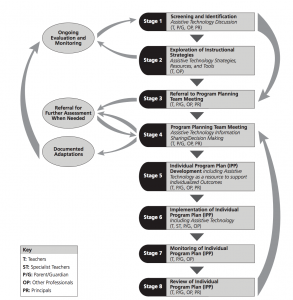Assistive Technology
Student Services » Assistive Technology
The Assistive Technology department provides assessment and intervention to students experiencing difficulties accessing curriculum in grades primary to twelve.
Assistive Technology is a range of strategies and resources which includes services and tools used to enable a student to meet outcomes or to improve or maintain a student’s ability to meet outcomes. Assistive technology has the potential to increase a student’s control over objects, daily activities, age-appropriate experiences and subsequent learning. The use of AT should not be viewed as an activity in itself, but as a means toward achieving goals. The program planning process should be used to identify and utilize appropriate assistive technology to achieve outcomes and maximize student participation. (Supporting Student Success: Assistive Technology – 2006)
Assistive Technology ranges from simple apparatus, such as a single switch access button, to complex tools, such as computer aided speech devices (Augmentative Communication Devices). According to the Special Education Policy Manual, Policy 1.5, when a student with special needs is identified either through family supplied information or through school board personnel, the classroom teacher uses available material and human resources to explore a variety of strategies in the learning process. The following resource can help teachers with ideas for exploration of instructional strategies.
If it is determined that these strategies are not working effectively, it is then the responsibility of the Regional Centre to implement a program planning committee to assess the student’s needs and to determine the kind of programming and services that should be provided to that student. This involves consulting with and mediating among diverse stakeholders, such as teachers, parents, medical and/or psychological personnel, speech-language pathologists and advocacy groups. Many times, the result will be that students will require some type of assistive technology. All of these procedures are identified in the Nova Scotia Department of Education and Culture Special Education Policy Manual.
Assistive Technology in the Program Planning Process
Assistive Technology ranges from simple apparatus, such as a single switch access button, to complex tools, such as computer aided speech devices (Augmentative Communication Devices). According to the Special Education Policy Manual, Policy 1.5, when a student with special needs is identified either through family supplied information or through school board personnel, the classroom teacher uses available material and human resources to explore a variety of strategies in the learning process. The following resource can help teachers with ideas for exploration of instructional strategies.
Assistive Technology may be considered at any stage of a student’s learning development. An assessment may be initiated by the school’s program planning team, which may include principals, classroom teachers, specialist teachers, parents/guardians and/or other professionals. To initiate an assessment, an Assistive Technology referral form must be completed in TIENET and forwarded to the Assistive Technology Consultant. The referral form is comprised of three components: school referral form, parental form, and a follow up form which is to be completed three months after the technology has been implemented. Assessments are done in the school setting by a member of the Assistive Technology team. Appropriate hardware and software is obtained through the cooperation of the Student Services Department, the Technology Department, and the school



